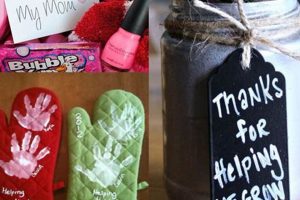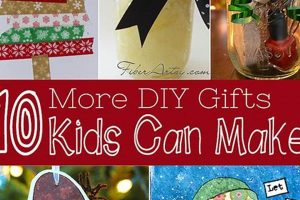The creation of miniature winter scenes encased in glass, frequently involving water and simulated snow, is a popular holiday craft project. These decorative items typically feature figurines or small scenes relating to the Christmas holiday, viewable through a clear container when shaken, causing the “snow” to swirl around the display. These are often constructed at home utilizing common household materials.
Engaging in such projects offers creative expression, fostering a sense of personal accomplishment through hands-on activity. Furthermore, the handcrafted nature of these items adds sentimental value, making them treasured keepsakes or personalized gifts. Historically, the practice of creating enclosed miniature scenes has evolved from paperweights to sophisticated decorative objects, reflecting changing artistic trends and technological advancements.
The subsequent discussion will delve into the materials required, the assembly process, and potential customization options for constructing these holiday-themed decorations. Exploration of suitable adhesives, appropriate figurines, and techniques for achieving optimal visual effects will be included.
Essential Guidance for Constructing Holiday Snow Globes
The following section provides focused guidance to facilitate successful creation of homemade holiday snow globes. Consideration of each point will enhance the final aesthetic and structural integrity of the craft project.
Tip 1: Container Selection: Choose a jar or container with a wide mouth to facilitate easy arrangement of the interior scene. Ensure the lid provides a watertight seal to prevent leakage and maintain clarity of the internal environment. Cleanliness is paramount.
Tip 2: Figurine Preparation: Select figurines crafted from waterproof materials like plastic or resin. Adhere figurines securely to the inside of the lid using a waterproof adhesive, allowing ample drying time before submersion in liquid. Test the bond before proceeding.
Tip 3: Snow Selection: Opt for artificial snow composed of glitter, small plastic flakes, or ground eggshells. Avoid materials that dissolve or discolor in water. Experiment with different textures to achieve the desired visual effect.
Tip 4: Liquid Medium: A mixture of distilled water and glycerin is recommended. Glycerin increases the viscosity of the water, allowing the “snow” to fall more slowly and gracefully. Proportions may vary depending on the desired effect; experimentation is encouraged.
Tip 5: Sealing the Globe: After arranging the scene and filling the container with the liquid medium, securely fasten the lid. Consider applying a bead of waterproof sealant around the lids edge for added protection against leaks. Invert the globe slowly to observe the snow’s movement.
Tip 6: Lid Decoration: Enhance the exterior of the snow globe by decorating the lid. Options include painting, ribbon, or small decorative elements secured with adhesive. Ensure the decorations do not interfere with the lid’s ability to create a secure seal.
The meticulous application of these recommendations will contribute to the creation of a visually appealing and structurally sound decorative object. Attention to detail and careful execution are paramount.
The subsequent section will explore advanced techniques and creative embellishments to elevate snow globe design further.
1. Watertight container selection
The success of a “diy christmas snow globe” is intrinsically linked to the selection of a watertight container. Without a hermetic seal, the liquid medium will leak, compromising the internal scene and potentially damaging surrounding surfaces. This selection dictates the structural integrity and longevity of the decorative item, affecting both its aesthetic value and functional lifespan. Real-life examples of failed “diy christmas snow globe” projects often stem from utilizing containers with compromised seals or inappropriate materials prone to degradation upon prolonged exposure to liquid. The practical significance of this understanding lies in preventing wasted time, materials, and the disappointment associated with a failed craft project.
A suitable container necessitates meticulous inspection for cracks, chips, or imperfections that could compromise its watertight capacity. The closure mechanism, be it a screw-top lid or a clamp, must effectively compress against a sealing surface. Selection considerations extend beyond mere leak prevention; container clarity is paramount for optimal viewing of the internal scene. Discolored or opaque containers diminish the visual appeal of the assembled snow globe. Furthermore, the mouth of the container must be sufficiently wide to allow for easy arrangement and manipulation of internal components.
In summary, watertight container selection forms a foundational element in “diy christmas snow globe” creation. Neglecting this aspect inevitably leads to structural instability and visual degradation. While creative embellishments and artistic arrangements contribute to the overall appeal, they remain secondary to the fundamental requirement of a securely sealed, transparent enclosure. Selecting the appropriate container presents an initial challenge, yet its importance cannot be overstated for achieving a satisfactory and enduring result.
2. Figure material suitability
The selection of appropriate materials for the internal figures within a “diy christmas snow globe” is not merely an aesthetic consideration, but a crucial factor determining the item’s longevity and overall quality. Material incompatibility with the liquid medium can lead to degradation, discoloration, and ultimately, the failure of the display.
- Waterproof Integrity
The primary requirement is that the figure material be impervious to water. Porous materials, such as untreated wood or certain types of clay, will absorb the liquid medium, causing swelling, deformation, and potential disintegration over time. An example of this would be an unsealed wooden figurine that, after prolonged submersion, swells and cracks, releasing tannins that discolor the water. Choosing materials known for their non-absorbent properties is crucial for preserving the figure’s structural integrity.
- Chemical Stability
The material must be chemically inert within the liquid environment. Certain plastics or paints may leach chemicals into the water, causing clouding, discoloration, or even degradation of the figure itself. Some metallic paints, for instance, may corrode in water, releasing particles that contaminate the snow globe’s clarity. Chemical stability ensures the long-term preservation of both the figure and the overall aesthetic quality of the snow globe.
- Density Considerations
The density of the figure material affects its stability within the snow globe. Excessively buoyant figures may float inappropriately, disrupting the intended visual composition. Conversely, excessively dense figures may sink rapidly, obscuring the scene. The material’s density should be balanced to allow the figure to remain relatively stationary within the swirling “snow” and to settle gracefully when the globe is at rest. A heavy metal figure, if not appropriately anchored, could damage the glass or plastic of the container.
- Colorfastness
The chosen material should exhibit colorfastness, meaning its colors should not bleed or fade upon prolonged exposure to the liquid medium. Dyes and pigments in some materials are water-soluble and will leach into the surrounding water, resulting in a blurred or discolored figure and a compromised overall appearance. This is particularly noticeable with poorly sealed painted figures. Selecting materials with inherently stable pigments or using appropriate sealing techniques is essential to maintain the figure’s vibrancy over time.
These material properties collectively dictate the visual appeal and durability of the internal figures within a “diy christmas snow globe”. Selection of unsuitable materials will inevitably lead to deterioration and a diminished aesthetic experience, while careful consideration and appropriate material selection yield a long-lasting and visually pleasing decorative item.
3. Simulated snow composition
The simulated snow composition constitutes a defining element within the “diy christmas snow globe.” Its characteristics directly influence the aesthetic appeal and the overall visual effect achieved when the globe is agitated. The choice of material acts as a critical determinant of the snow globe’s success or failure. An unsuitable composition will diminish the viewing experience, potentially rendering the handcrafted object visually unappealing. For example, using sugar as the simulated snow would lead to dissolution within the liquid medium, resulting in a cloudy and ultimately barren interior. Conversely, a carefully selected material that is both visually appealing and chemically stable contributes significantly to the overall immersive experience.
Further analysis reveals practical considerations surrounding the particle size and density of the simulated snow. Overly large particles may settle too quickly, negating the desired effect of a gentle snowfall. Conversely, excessively fine particles might remain suspended indefinitely, clouding the liquid medium and obscuring the internal scene. Ideally, the particles should possess a density close to that of the liquid medium, allowing for a slow and graceful descent. The choice of material also has implications for the longevity of the snow globe. Certain materials may react with the liquid medium, causing discoloration or degradation over time. Glitter, a commonly used option, should be of a high quality to prevent fading or leaching of color. The quantity of simulated snow must be carefully calibrated to achieve the desired visual density without obscuring the internal figures.
In conclusion, the composition of the simulated snow is fundamental to the visual integrity and overall success of a “diy christmas snow globe.” A thoughtful approach to material selection, particle size, density, and chemical stability ensures a visually compelling and long-lasting handcrafted object. While decorative elements contribute to the overall design, the simulated snow is intrinsically linked to the core aesthetic, providing an essential element of the immersive experience. Choosing the right material presents unique challenges, particularly balancing aesthetic desires with the functional and chemical constraints imposed by the enclosed environment.
4. Liquid medium viscosity
The viscosity of the liquid medium within a “diy christmas snow globe” directly influences the visual dynamic of the falling simulated snow, significantly affecting the overall aesthetic quality. This property governs the rate at which the simulated snow particles descend and dictates the duration of their suspension, thus playing a pivotal role in the perceived realism and charm of the decorative item.
- Snowfall Rate
Increased viscosity slows the descent of simulated snow, creating a prolonged and more visually appealing snowfall effect. A liquid medium with low viscosity allows the snow to plummet rapidly, diminishing the realism and aesthetic value. Example: Distilled water alone provides minimal resistance, causing glitter to fall quickly. The addition of glycerin significantly increases viscosity, slowing the descent and enhancing the snowfall illusion.
- Suspension Duration
Higher viscosity extends the period during which the simulated snow remains suspended in the liquid. This prolonged suspension enhances the visual complexity of the snow globe, allowing for a more captivating display. In a low-viscosity medium, the snow settles almost immediately, leaving a static scene. With appropriate viscosity, the swirling snow remains suspended for a considerable duration after agitation.
- Clarity Maintenance
The correct viscosity can help maintain clarity within the snow globe. A medium with inadequate viscosity may allow simulated snow particles to clump together or settle unevenly, leading to cloudiness or an obscured view of the internal scene. Glycerin, when used in moderation, aids in dispersing the particles and preserving a clear viewing field.
- Material Compatibility
The liquid medium’s viscosity influences the behavior of different simulated snow materials. Finer particles require a higher viscosity to remain suspended effectively, whereas coarser particles may function adequately in less viscous mediums. Matching the viscosity of the liquid to the particle size of the simulated snow is crucial for achieving the desired visual effect. Incompatibility can result in either excessive clumping or overly rapid settling, depending on the combination of materials.
In summation, meticulous control over the liquid medium’s viscosity is essential for optimizing the visual performance of a “diy christmas snow globe.” By manipulating the viscosity, the creator can fine-tune the snowfall rate, suspension duration, clarity, and material compatibility, resulting in a more visually engaging and aesthetically pleasing decorative object. Failure to consider viscosity can result in a subpar visual experience, undermining the overall effectiveness of the snow globe.
5. Aesthetic lid embellishment
Aesthetic lid embellishment, while often considered a secondary aspect of “diy christmas snow globe” construction, plays a vital role in augmenting the overall visual impact and thematic consistency of the decorative item. The lid, being a prominent external feature, offers a canvas for creative expression and provides an opportunity to reinforce the intended artistic message. Neglecting this element can result in an incomplete or visually dissonant final product.
- Material Harmony
The selection of embellishment materials must harmonize with the materials used within the internal scene and the container itself. Incongruent materials can detract from the overall aesthetic coherence. For instance, a rustic, hand-painted lid may clash with a highly polished, modern glass container. Careful consideration of textures, colors, and finishes is essential to establish a unified visual theme.
- Thematic Reinforcement
Lid embellishments should reinforce the central theme of the snow globe. A snow globe featuring a winter forest scene could incorporate miniature pinecones, artificial snow, or small woodland creatures affixed to the lid. Conversely, a snow globe depicting a Christmas nativity scene might benefit from a simple, elegant design that does not detract from the religious significance of the internal display. The embellishments serve as a visual cue that complements and enriches the narrative presented inside the globe.
- Functional Considerations
While aesthetic appeal is paramount, functional considerations must not be overlooked. Embellishments should not impede the lid’s ability to securely seal the container, nor should they be excessively fragile or prone to detachment. Overly bulky embellishments can also make the snow globe unwieldy or difficult to store. Balancing aesthetic desires with practical functionality is crucial for creating a durable and user-friendly decorative item.
- Personalization and Creativity
The lid provides an excellent avenue for personalization, allowing the creator to inject their individual artistic style into the “diy christmas snow globe.” This may involve painting, sculpting, applying decoupage techniques, or incorporating meaningful personal objects. This opportunity for self-expression transforms the snow globe from a generic decoration into a unique and cherished keepsake. However, ensuring the personalization remains in aesthetic harmony with the rest of the snow globe is the key to a balanced design.
In conclusion, careful attention to aesthetic lid embellishment enhances the overall visual appeal and thematic coherence of a “diy christmas snow globe.” The lid, as a prominent external feature, provides an opportunity to reinforce the artistic message, personalize the creation, and elevate it from a mere decorative item into a handcrafted work of art. Integrating aspects such as material harmony, thematic reinforcement, functional considerations, and personalization are essential when designing lid embellishments. These choices allow creators to develop distinct visual representations that will be treasured and exhibited with great pleasure during the holiday season.
Frequently Asked Questions Regarding “diy christmas snow globe” Construction
The following section addresses common inquiries and clarifies potential points of confusion surrounding the creation of homemade Christmas snow globes. These questions aim to provide practical guidance for achieving successful results.
Question 1: What adhesive is recommended for securing figurines within a submerged environment?
A waterproof epoxy resin adhesive is generally recommended. Cyanoacrylate adhesives (super glue) may exhibit limited long-term resistance to moisture and submersion. Ensure the selected adhesive is chemically inert and does not leach harmful substances into the liquid medium.
Question 2: Is tap water suitable for use as the liquid medium in a Christmas snow globe?
Distilled water is preferable to tap water. Tap water often contains minerals and impurities that can cloud the liquid medium over time, reducing the clarity of the display and potentially promoting the growth of microorganisms.
Question 3: What alternatives exist for simulated snow besides glitter?
Alternatives include finely ground eggshells, small plastic flakes specifically designed for crafting purposes, and certain types of synthetic flocking material. Exercise caution when selecting alternatives, ensuring the material is both non-toxic and chemically stable within the liquid medium.
Question 4: What is the optimal ratio of glycerin to water for achieving a slow snowfall effect?
The optimal ratio varies depending on the desired effect and the particle size of the simulated snow. A starting point of 1:3 (glycerin to water) is suggested, with adjustments made incrementally until the desired snowfall rate is achieved. Overuse of glycerin can result in a viscous, almost immobile, suspension of the simulated snow.
Question 5: How can potential leaks be prevented or addressed in a completed snow globe?
Prevention involves ensuring a tight seal between the lid and the container using a rubber gasket or O-ring. For added security, a bead of waterproof silicone sealant can be applied around the edge of the lid after it has been securely fastened. Minor leaks can sometimes be addressed by carefully applying additional sealant to the exterior of the lid-container interface.
Question 6: What are the safety precautions associated with working with glass containers during this crafting project?
Handle glass containers with care to avoid breakage. Work on a stable surface and wear safety glasses to protect against potential shards in the event of accidental shattering. Supervise children closely when they are involved in the project, and ensure they understand the potential hazards associated with handling glass.
In essence, careful planning, informed material selection, and attention to detail are critical for successful “diy christmas snow globe” construction. Adhering to these guidelines minimizes potential issues and maximizes the likelihood of a satisfying creative experience.
The subsequent section will provide step-by-step instructions accompanied by illustrative examples for how to make a diy christmas snow globe.
Concluding Remarks on “diy christmas snow globe” Crafting
This exploration of “diy christmas snow globe” construction has emphasized critical elements impacting the aesthetic and structural integrity of these handcrafted items. These considerations span material suitability, liquid medium properties, container selection, and lid embellishment techniques. Precise adherence to these guidelines is essential for achieving optimal results.
The creation of these miniature winter scenes, while a pursuit of individual creativity, carries broader significance. These crafts offer a tangible embodiment of holiday spirit and provide opportunities for personalized gift-giving. The successful execution of a “diy christmas snow globe” becomes a testament to meticulous planning and skillful execution, a small yet meaningful contribution to seasonal celebrations.







